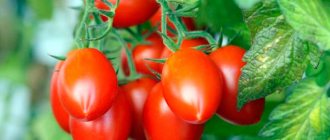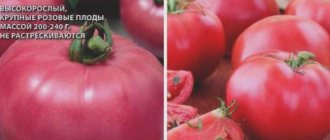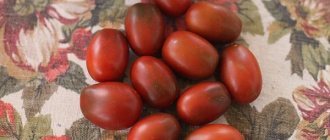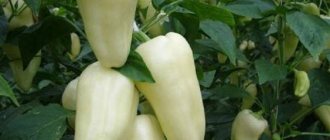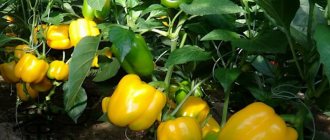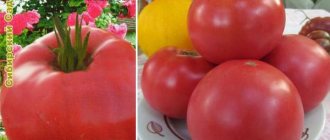The Heart Kiss tomato has gained millions of fans; it is a famous Russian variety. Undemanding in care, highly productive, replete with heart-shaped fruits. Thanks to early fruiting, it practically does not suffer from late blight. Brings stable harvests in various regions.
| Height | Landing location | Ripening time | Fruit color | Fruit size | Origin | Fruit shape |
| Medium height | Greenhouse, Open ground | Mid-early | Reds | Large | Variety | Heart-shaped |
Tomato Heart Kiss
Mid-season, medium-sized, large-fruited tomato variety for greenhouses and open ground.
The bush is of an indeterminate type, thin, requiring tying to a support and pinching. The height of the bush in the greenhouse is 1.2-1.3 meters, in the greenhouse it is lower. There are 6 fruits in a brush. The variety showed good results when forming plants with 2 and 3 stems.
Fruit characteristics
The fruits are heart-shaped, beautiful, dense, rich red in color at maturity, weighing 150-300 grams (up to 500 g), fleshy, with tasty tender pulp. These tomatoes are good for fresh consumption, as well as for making juice and thick sauces.
Features of growing tomatoes Heart Kiss
Sowing the seeds of this variety of tomatoes for seedlings is carried out 60-65 days before the intended planting in the ground. Seedlings dive at the stage of two true leaves. When planting seedlings in a permanent place per 1 sq. It is recommended to place up to 3 plants per meter of land; when forming into 1 stem - up to 4.
Further care for tomatoes consists of timely watering, fertilizing with complex mineral fertilizer, pinching and preventive measures to protect against diseases and pests.
If you grew Heart Kiss tomatoes, please write whether you liked them or not. What was the yield and taste of the fruits like under your climatic conditions? How do you rate the disease resistance of this variety? If possible, attach a photo of your tomatoes to your comment. Thank you!
Your reviews of the Heart Kiss tomato and additions to the description will help many gardeners evaluate this variety more objectively and decide whether it is worth planting or not.
Features of the variety
You can grow Heart's Kiss tomatoes in any conditions - both in open ground and in film structures. The height of the bush when growing the plant in summer cottages does not exceed 0.7 cm, while a greenhouse plant of this variety reaches 1.2 m in height and needs to be tied to a support.
The plant is characterized by a small amount of green tops and inflorescences of a regular shape. Tomato brushes have the appearance of a bunch.
Heart Kiss refers to tomatoes that have an average ripening period. The collection of ripened fruits begins 90 days after the appearance of the first shoots. The fruits have an unusual, sweetish taste and are actively used for preparing salads, as well as preparations for the winter.
Agronomists note several main differences that distinguish this variety from many others:
- High yield.
- Successful growth and fruiting in regions of risky farming.
- Resistance to a number of located diseases leading to plant death.
- A large number of tomatoes on the plant.
Tomato Bull's Heart - description of the variety with photo
Advantages of the Ox Heart variety:
- large-fruited fruits, especially on the lower clusters;
- very tender, sweet and fleshy pulp;
- there are various subspecies;
- has a high germination rate of planting material;
- the fruits set together;
- good yield indicators;
- can be grown both in a greenhouse and in open ground;
- plants are drought resistant;
- immunity to most diseases, in particular late blight.
- the need for stepson, formation and garter of bushes;
- If not properly cared for, it can be affected by certain types of diseases.
Productivity
You can harvest such a harvest only if you choose good seeds and also adhere to all the rules for caring for plants of this variety.
The fruits can be collected both at the technical stage of ripeness (greenish tomatoes) and at the biological stage (red tomatoes). But while the tomatoes are still unripe, it will be difficult to understand whether they have reached their size or will continue to grow.
Therefore, if there is a need to remove unripe tomatoes, then you should focus on changing the color. As soon as a yellow or brown tint appears, you can pick it.
Variety varieties
The difference between Bull's Heart and other varieties is that the variety has several subspecies that differ in color. In addition to traditional red tomatoes (red ox heart), there are the following varieties:
- Golden Bull's Heart. The fruits of this subspecies are cone-shaped and golden-yellow in color. The weight of tomatoes is 400-750 grams. The skin is dense. The taste is sweet. The yield is average, lower than that of the “red heart”.
- Pink Ox heart. The tomatoes are bright pink. The weight of the fruit reaches 1 kilogram. The skin is thin but dense. Maturation occurs a little later than other species. The fruits are very well stored. Plants have increased resistance to various diseases. Easy care and many advantages make this variety of Ox's Heart quite popular among gardeners.
- White Bull's Heart. The fruits of this variety are white. The weight of a tomato can reach up to 800-900 grams. Fruits for a long time. Fruiting stops immediately after the onset of the first cold weather.
When the seedlings grow to 20-25 cm in height, they need to be transplanted into a greenhouse. As a rule, this is done in mid-April. The greenhouse should be well heated and well lit.
Seedlings are planted at a distance of one meter from each other. I make holes 15 cm deep and add humus. After planting, the plants are watered well with warm water.
Greenhouse care
The air temperature in the greenhouse is maintained at 20-22 °C during the day and 16-18 °C at night. Water the plants once every 7 days. For 1 sq. meter uses about 7 liters of water. During the period of fruit formation, the amount of water is increased to 15 liters per 1 square meter. meter.
The greenhouse is ventilated every day for 30 minutes. Tomatoes are pollinated by hand. The bush must be formed and the stepsons removed. Organic fertilizers are applied every two weeks.
Growing tomatoes in open ground
The bed has been prepared since the fall. All weeds are removed, rotted manure is added, and the soil is dug well. Seedlings are planted in early May.
Care
Plants are fed 2 weeks after planting with organic fertilizers.
- After the first feeding, a layer of mulch no more than 5 cm thick is poured onto the ground. Pine needles, sawdust or straw are used.
- The plants are fed a second time ten days after the first ovaries appear. 2 liters of manure solution are poured under one tomato bush.
- The plants are fed the third time during the ripening period. Pour 2.5 liters of manure solution under each tomato bush.
Water the plants strictly at the roots, twice a week. If the weather is hot - 3-4 times a week. Also, the bushes are formed, tied to a trellis and the stepsons are cut off.
Ninulia, southeast of the Nizhny Novgorod region
Tomato variety "Bull's Heart". Growing secrets - video
The Oxheart tomato is a tomato with excellent taste, but it requires special attention. In this regard, the variety is not suitable for those gardeners who do not have the opportunity to spend a lot of time in their beds. Give the variety enough attention, and you will get an excellent harvest of large and juicy tomatoes.
Tomato Kiss: description of an early variety of cherry tomatoes, advantages and disadvantages of the new product
Description of the cherry tomato variety Kiss
In recent years, vegetable growers in various Russian regions are increasingly growing cherry tomatoes in their garden plots. Currently, breeders have developed many varieties of cherry tomatoes, the bushes of which, during the ripening period, are simply hung with small sweet fruits. The color of ripe small tomatoes can be different; they are united by the size of the fruit, good yield, excellent taste and a number of other positive characteristics.
This article will talk about the Kiss cherry tomato, which is an early-ripening and fairly productive variety.
History of creation
The tomato variety Kiss was bred by breeders from the agricultural company Partner and is recommended for cultivation not only in garden beds in open ground, but also in greenhouse conditions.
Description of the tomato variety Kiss
Tomato Kiss belongs to the indeterminate type,
therefore, bushes of this variety can reach a height of up to 1.5 m when grown in garden beds, and about 1.9 m in greenhouse conditions. Usually, the tops of tomato bushes of this type are pinched at a certain height so that these plants do not grow, and all the fruits that were set could ripen on them.
Photo of tomato Kiss
The Kiss tomato variety is early ripening,
From the germination of seed material to the harvesting of ripe products, it takes just over 3 months.
The bushes are tall, powerful, medium leafy. The shoots are erect and strong, but during the ripening process they require garters, as they can break off under the weight of ripening bunches of small tomatoes. It is recommended to place supports under huge bunches.
The foliage is medium in size, oval-elongated, slightly wrinkled, with small sharp tips, rich emerald color.
Tomato variety kiss – video
The flowers are small in size with yellow petals, collected in complex, large racemose inflorescences. Each of these inflorescences bears up to 140-150 fruits.
It is noted that this variety is resistant to stressful situations, tolerates changes in weather conditions well, and does not reduce the rate of growth and fruit set even under unfavorable conditions.
Main characteristics
Ripe fruits of this variety are small in size and weight, the weight of one Kiss tomato reaches 25 g. The shape of the fruit is obovate with a thin spout at the end of the tomato. The taste of the fruit is pleasant, with a characteristic sourness, in a word - a typical tomato taste.
Ripening tomatoes can hang on the bushes for a long time, do not fall off and do not lose their taste and presentation. Usually these cherry tomatoes are removed from the bushes with tassels.
These tomatoes are versatile - they are used to decorate various dishes and salads, eaten fresh, added to snacks, and canned whole and frozen for the winter.
Tomato yield Kiss
The originator of this variety notes that the productivity of the Kiss tomato is high - in greenhouses, up to 22 kg of ripe tomatoes are usually harvested from each square of area, and about 16 kg in open ground beds.
This yield for cherry tomatoes is high, especially considering that no more than two bushes are grown per square meter. It turns out that from each Kiss bush, up to 11 kg of tomatoes are harvested in greenhouse conditions per season, and 8-9 kg in the garden.
How TOMATO blooms - video
Diseases and pests
Tomato Kiss is resistant to most diseases characteristic of other tomato varieties.
However, if the rules of agricultural technology (especially the irrigation regime) are not followed, then the bushes of these tomatoes may be subject to fungal diseases or various rots.
Therefore, you should monitor the soil moisture, fertilize the tomatoes on time, and periodically treat the Kiss tomato bushes with Bordeaux mixture or copper sulfate solution.
Among the pests, this variety can be damaged by aphids and the Colorado potato beetle.
Insecticides should be used against them, and many vegetable growers prefer to regularly pick off the Colorado potato beetle by hand.
The last treatment of tomatoes with chemicals should be done no later than a couple of weeks before harvest.
Photo of the Colorado potato beetle on tomatoes
Advantages of the variety
The main advantages of the Kiss tomato variety include:
- early fruit ripening;
good germination of seed material;
the ability to collect seeds from bushes in your garden;
The Kiss tomato is a variety of cherry tomatoes with small fruits;
ripe tomatoes can hang on the bushes for a long time and do not fall off;
120-145 small fruits are usually formed on one cluster;
excellent taste of the Kiss tomato;
variety resistance to most diseases;
Photo of tomato pulp Kiss
This variety has no particular disadvantages. But many vegetable growers believe that the seeds are quite expensive, and there are only 10 pieces in a bag. It should also be remembered that shoots and brushes should be tied to strong supports.
How to plant tomatoes Kiss
Typically, the Kiss tomato variety is grown in seedlings.
All stages of planting and further care of these vegetable plants will be discussed below.
TOMATOES FROM A TO Z: variety selection, sowing, seedlings, planting tomatoes - video
Seed preparation
You can purchase seed material of this variety in specialized garden stores. But once you plant the Kiss tomato in your beds, you can later collect the seeds yourself.
Photo of tomato seeds in salted water
Store-bought tomato seeds Kiss from Agro do not require pre-sowing preparation; they can be soaked in a solution of growth stimulants before sowing.
Rules for growing the variety
Proper cultivation of Red Oil Heart tomatoes guarantees a rich and high-quality harvest. In the southern part of Russia, tomatoes of this variety are grown in garden beds, and in the central and northwestern regions, in Siberia, in greenhouses.
Seed material for seedlings is planted in late February - early March. Planting in a permanent place is possible only in consistently warm weather and warm soil. Up to 3 plants are planted per square meter. Proper planting guarantees the possibility of successfully growing Red Butter Heart tomatoes, which are recommended to be tied to a support or trellis for guaranteed reliability.
In the future, comprehensive and constant care for the Red Oil Heart variety is required. At the same time, care is based on classical principles, so a rich harvest is guaranteed.
- The formation of a tomato bush is mandatory, because the variety in question has a powerful stem, abundantly growing branches and numerous leaves and fruits. It is advisable to form 1-2 stems and remove side shoots to obtain a high-quality harvest. It is best to remove the shoots in the morning so that by evening the wound can heal and the plant is protected from possible infections.
- The tomato bush is pinched as it grows, as control over its growth is required. In this case, the plant’s strength will be spent on ripening the fruits and increasing the yield.
- Regular watering plays an important role. It is advisable to ensure that the soil receives the optimal amount of moisture. For this reason, it is advisable to water 1-2 times a week.
- Mulching and loosening the soil are mandatory measures to improve the access of oxygen to the soil and remove weeds.
- Feeding is mandatory. However, an excess of nutrients (primarily nitrogen) is not allowed. Nitrogen fertilizers are required only in the first stage. then you need to focus on phosphorus, potassium, and various microelements. It is best to alternate root and foliar application of fertilizers.
- Fruiting is long-lasting, so fruit collection is carried out approximately twice a week. Only closer to autumn are all the fruits harvested. Green tomatoes ripen at home.
The correct approach to growing tomatoes of the Red Butter Heart variety guarantees the possibility of obtaining the desired harvest in the shortest possible time.
Growing Issues
The plant is grown by seedlings. The planting time will be determined depending on the planned harvest date and the climatic conditions of the area. Sowing is carried out in small containers in pre-prepared soil. Before planting, it is recommended to treat the soil with potassium permanganate or a special preparation that prevents the occurrence of fungal plant diseases.
Cultivation is carried out at a room temperature of 23–25 C°. Seedlings respond well to moderate watering and the addition of mineral fertilizers. If there is a lack of sunlight, it is recommended to provide the shoots with additional lighting to prevent them from stretching and thinning.
READ MORE: Spinach for the winter: harvesting at home, recipes with photos
The recommended time for planting seedlings in a permanent place is considered to be 55 days of age of the shoots. Typically, transplantation is carried out in May or June, depending on the time of sowing the planting material and the climate of the area. The plant loves fertile soil made from the following components:
- peat;
- sand;
- humus;
- organics;
- mineral fertilizers.
The shoots are formed into one main stem, tied and periodically pinched. Removing excess green mass contributes to better nutrition of the bushes and increases productivity.
With late planting and low ambient temperatures, not all the fruits of the plant have time to fully ripen. In this case, the tomatoes are collected and kept in a dark room until they turn completely red.
- Receive and sign the bed for the planned time of planting the seedlings.
- Climatic features of the region.
For 100% seed germination, what can you do to create the appropriate conditions:
- Stable temperature conditions. The air temperature in the room should always fall below 23-25 degrees Celsius.
- Regular, regulated watering. The earthen clod must not be allowed to dry out. The soil should be irrigated as its top layer dries.
- Fertilizer application. For the sake of proper development, a young plant needs feeding with mineral fertilizers and biostimulants.
- Good interpretation. In case of insufficient natural light, experienced gardeners recommend illuminating the young plants using ultraviolet lamps.
- Seedlings that have reached 55 days of age can be moved to a permanent place of growth. Usually transplantation is carried out in the phase from May to June. Agronomists recommend acclimating young plants to a permanent habitat using a hardening scheme.
- The soil in the garden also requires preliminary preparation. It is a good idea to treat it with drugs that can prevent the development of fungal diseases.
Features of cultivation, planting and care
We recommend sowing the seeds of this tomato variety for seedlings 55-60 days before the intended planting in the ground. Seedlings dive at the stage of two true leaves. When planting seedlings in a permanent place per 1 sq. Place 3-4 plants per meter of plot.
Further care for tomatoes consists of timely watering, pinching, fertilizing with complex mineral fertilizer and preventive measures to protect against diseases and pests.
If you grew Sweet Kiss tomatoes, please write whether you liked them or not. What was the yield and taste of the fruits like under your climatic conditions? How do you rate the disease resistance of this tomato? If possible, attach a photo of the entire bush or individual fruits you grew to your comment. Thank you!
Your reviews of the Sweet Kiss tomato and additions to the description will help many gardeners evaluate this variety more objectively and decide whether it is worth planting or not.
Characteristics and description
The variety has excellent taste and high resistance to diseases. Siberian cherry is not at all afraid of cold weather. The first fruits ripen approximately 90 days after sowing the seeds. Sweet kiss tomato description, reviews, photos and yield characterize it as one of the best cherry varieties.
Characteristics and description of the variety:
- the variety is resistant to all diseases characteristic of nightshades;
- The tomato is mid-season, the first fruits can be tasted in early summer;
- high-yielding variety;
- fruits with a sweet, rich taste;
- a large number of fruits are formed on the cluster, which have time to ripen well until the end of the season;
- The fruits are universal in their intended purpose.
According to the observations of experienced gardeners, small tomatoes love heat very much, so greenhouse conditions are closer to them.
Description of the bush
The bush is of medium size, reaches a height of 0.8-1 m, but often grows up to 1.5 m. Requires regular removal of stepsons and tying up. It bears fruit well if you form a bush of 2-3 stems. The inflorescences are simple, the foliage is not dense. Clusters of several pieces are formed on the bush. In the bunch you can count many fruits that have time to ripen well before the end of the season.
Description of the fruit
The tomatoes are small, round, weighing 20-25 g. As a rule, a lot of them grow on a bunch. They have a dense structure and a rich, unique sweet taste. It is for this taste that Sweet Kiss has gained many fans among gardeners and gardeners.
Productivity and keeping quality
With proper care, the fruits yield a harvest from 1 square meter. m up to 10 kg of beautiful tomatoes. The culture is resistant to almost all diseases. Sweet Kiss tomatoes tolerate transportation well, maintaining their beautiful appearance. If stored properly, they can be stored for a month or more.
Purpose
The fruits of the Sweet Kiss variety are widely used in cooking. They are especially good in salads and fresh. Due to the fact that they have a unique taste, various dishes are prepared from them and canned. Particularly noteworthy are the pickled cherry tomatoes; in this form they are simply incomparable. A very unique dish is dried tomatoes for the winter; this variety is ideal for such preparation.
Advantages and disadvantages
Sweet kiss has a number of undeniable advantages, which once again prove that cherry tomatoes simply need to be grown on your own plot.
- the variety can be called problem-free;
- It is perfectly stored and easily tolerates transportation, thanks to the thick skin and dense structure of the fruit;
- can be grown in a greenhouse and open ground;
- adapts perfectly to any climate.
The main advantage of the variety is the unique taste of the fruit, which both children and adults simply adore.
Fruit characteristics
The fruits of the Natural Kiss variety have a rich red hue and a neat shape reminiscent of a headquarters. The berries have a shiny, smooth skin and are not prone to cracking during ripening and during heat treatment.
Agronomists note the high yield of the variety, which averages 3.5 kg per bush. The weight of each greenhouse tomato is 300 g, which indicates the large size of the berries. The sympathetic kiss, grown in open beds, cannot boast of large sizes, and on display the appearance of the fruit resembles enlarged cherry tomatoes.
The taste characteristics of the berries are high. The sweetish imprint of the berries is due to the increased sugar content.
Experienced summer residents note that the last crop of tomatoes may not ripen at the same time. In this case, it is recommended to place the fruit in a dark, cool place until it turns completely red.
All about the variety
The description of the Sweet Kiss variety is written on the seed package. Ripens approximately three months after sowing the seeds. Refers to small tomatoes. Adapts perfectly to any weather changes and tolerates cold weather well.
The fruits are round in shape. There are always a lot of them on a branch. The color is red. The skin is dense, smooth, shiny. These tomatoes are recognized as one of the sweetest varieties in the world. The taste and aroma are unique, rich tomato. They contain a large amount of sugar. Small cherry tomatoes are ideal for salads and slices. And when marinated, they turn out simply incomparable.
If someone wants to plant these crops in their garden, then they need to know how to grow them correctly and what conditions to create for the growth of this variety.
Features of care
- Implementation of timely watering.
- Loosening the soil.
- Timely removal of weeds.
- Periodic stepsoning.
- Application of organic fertilizers.
- Tying to a support.
- Timely collection of ripened fruits.
The variety Heart Kiss has gained its popularity among summer residents living in different climatic conditions. Its taste characteristics exceed all expectations, the shape of the fruit is surprising, and the yield and immunity prompt the desire to grow tomatoes on your own plot.
Growing the variety
“Ural Summer Resident” offers you a package of already processed seeds, usually their number in a pack varies from 10 to 15 pieces. The soil needs to be prepared a week before planting the seeds in the soil. So, we bring the soil from the garden to a warm place, leave it for 4-5 days so that the soil warms up well. Then we mix it with fertilizers and scatter it into boxes, where we will then plant the seed material. Pour boiling water over the resulting mixture to remove parasites and fungal spores. We repeat the procedure for three days. Next, we water the seeds with a growth accelerator and plant them in the soil. Typically the dates fall at the end of March or the beginning of April. If you purchased a ready-made soil mixture, then skip the step of cleansing the soil.
Attention! There is no need to carry out the seed disinfection procedure if you purchased planting material from a well-known agricultural company.
We cover our boxes with cling film and leave them in a warm, bright place for seedlings to appear. As soon as the stems break through the ground, remove the film and create the most favorable conditions for growth for the plant. Water them as the soil dries out, feed them with mineral fertilizers, which stimulate growth and strengthen the seedlings. After 4 true leaves appear, you can plant the bushes by transplanting the mature seedlings into separate containers, which can serve as disposable cups. Carefully ensure that the leaves do not turn yellow; if you notice the plants wilting, remove them away from direct sunlight. A week before transplanting the material, begin to harden the plant by taking it to a cooler room for a few minutes, each time the “walk” time should double.
Two months from the date of planting the seeds, the seedlings should already reach 15 cm in height; it’s time to replant them. If you grow tomatoes in a greenhouse, then transplantation occurs at the beginning of May. The plant should be transplanted into open ground in June, when the weather stabilizes and the earth warms up under the scorching rays of the sun. Carefully transfer one seedling into a deep hole, place it in the center of the hole and cover it with soil so that all the leaves are visible on the surface. Planting pattern 30*50 cm.
After all the material has been planted, the plants need to be watered. For watering, use only water at room temperature and water the bushes at the root. It is better to do this procedure in the evening or early in the morning, before the sun has risen. Feed the plant throughout the growing season. By the way, since the bushes are not limited in growth, during flowering it is recommended to pinch the tops so that it does not grow too much. Don't forget to trim the shoots once a week.
Reviews about the red loving heart tomato say that growing vegetables in greenhouse conditions is a little more difficult; several times a day you need to pollinate the flowers with your own hands, shaking the bushes, in order to have a lot of harvest. The greenhouse must also be ventilated regularly, otherwise the plants will suffocate. Whitefly is a frequent guest of greenhouse tomatoes. Getting rid of the moth is not difficult; you just need to spray the bushes with a soapy solution. The main thing is not to hold out until the moment when the so-called butterflies overcome all the plants.
Disease resistance in tomatoes is average, making the bushes more susceptible to the environment. The quality and quantity of the harvest depends on this. When infecting other vegetable crops, you need to be more careful and prevent the spread of infection. If you do not take care of the bushes and do not carry out preventive procedures on time, the plant can contract diseases such as:
- late blight;
- septoria;
- cladosporiosis;
- tomato mosaic.
The only way to get rid of all these diseases is to remove the infected areas by burning and treating the stem sections with a disinfectant. If the infection of tomatoes is at the initial stage, various liquids that are publicly available will help you. They can only be used after carefully reading the instructions. Recovery of the bushes may be delayed if the first fruits have already appeared on the bushes.
Description of the Maiden's Hearts tomato, characteristics and cultivation of the variety
Tomato Maiden's Hearts is intended for growing in a greenhouse. This is an indeterminate variety with an average start to fruiting and excellent taste of tomatoes.
Plant characteristics
Tomatoes of the Maiden's Heart variety were bred as a variety cultivated in greenhouses. The height of the bushes reaches up to 160–200 cm. Brushes are formed in the axils of the leaves, 4–5 pieces on one stem. Each cluster can have up to 5 fruits. The first ovary is formed above the 11th leaf, and subsequently every 3 leaves.
- The weight of one fruit often ranges from 150 to 170 g, although some tomatoes from the lower ovaries can grow up to 300 g.
- The total yield of these tomatoes is 10–11 kg per 1 m2.
- The fruits have a bright scarlet color.
- In shape they are slightly elongated downwards, which resembles the shape of a heart.
- They are quite juicy with increased sugar content.
- Ripe tomatoes have medium firmness.
The main purpose of Maiden's Hearts is to prepare salads and juices. Some also use them to prepare lecho and fillings.
Sowing and planting seedlings
This variety requires preliminary seedlings. Seeds should be planted 60–65 days before the seedlings are planned to be placed in the greenhouse.
3–4 plants are placed per 1 m². This variety requires mandatory removal of side shoots (pinching).
Plant care
In addition to the necessary weeding, hilling, watering and fertilizing, indeterminate varieties require pinching. In greenhouse conditions, it is preferable to grow varieties with tall stems in order to fill the volume of the structure as much as possible. There tomatoes can grow until frost.
The disadvantage of the characteristics of such plants is the increased formation and growth of stepsons. One or two side shoots can grow from one leaf axil. And if you feed frequently, the stepsons can also grow from flower clusters.
Too much thickening can slow down the process of fruit formation and ripening. In addition, excess green mass can make it difficult to move around the greenhouse.
As a rule, indeterminate tomato varieties are grown to form a single stem. In this case, all lateral processes are removed from it. On such a stem, 5–6 clusters of Maiden’s Heart tomatoes can form over the summer. Even novice gardeners can use this method of forming a bush.
Stepsoning
The lateral stem begins to form no earlier than the first flower cluster is formed. Directly below her, the stepson begins to grow. Sometimes the first side shoot is left before the first flower cluster, and then pinched after 2 leaves.
When removing a sheet, you need to make a sideways movement, not downwards. This can provoke the removal of the skin from the trunk, which will negatively affect the yield of the bush.
Description of fruits
The Heart Kiss variety is distinguished by its fruits. They are large, sweet and bright red in color. The main difference between these tomatoes is their shape, which resembles a heart.
- The fruits are suitable for any type of use, as evidenced by reviews from gardeners.
- The pulp of the Heart Kiss tomatoes is quite sugary and dense. Therefore, these tomatoes will be a good base for sauce or juice.
- However, tomatoes are especially good to eat fresh.
- These tomatoes are not suitable for canning, as they are quite large.
- The average weight of a tomato is 300 g. But huge fruits up to 800 g can appear on the lower branches.
Gardeners value Heart Kiss tomatoes not only for their shape, disease resistance and early ripening. One of the main advantages of this variety is its sugar content and very pleasant taste.
The Heart Kiss tomato appeared on the garden crops market recently and immediately gained popularity among lovers of unusual tomatoes. The plant is intended for growing in open space and in film structures. In the first case, the shoots are not very tall and the bushes reach a height of no more than 0.7 cm. When grown in a shelter, the plant can reach a height of up to 1.2 meters and in this case requires tying .
The description of the variety classifies it as a species with an average period of fruit ripening. The first harvest is harvested on average 3 months after the first shoots appear. Vegetables look great in salads and give them an unusual sweetish taste; they can be used in recipes when preparing preparations for the winter.
A spreading plant with a small amount of green mass is suitable for growing in difficult Siberian conditions and shows good yield in regions with a difficult climate and risky farming. The advantage of tomato is considered to be good resistance to various types of tomato diseases.
Description of the early ripening tomato Spring of the North F1 and rules for growing by seedling method
The early-ripening hybrid tomato Spring of the North was included in the State Register of Breeding Achievements back in 2011. Bred specifically for the industrial production of early vegetables, the variety has several advantages: uniform yield, calibrated fruits and compactness of the bush. Currently, hybrid seeds can also be purchased for planting in a summer cottage.
General characteristics of the plant
The description of the variety Spring of the North F1 in the State Register catalog indicates that this is a determinate plant. The growth of the main stem stops after the formation of 5-6 fruit clusters, after which the filling of the ovaries and the rapid ripening of the fruits begin. Mass harvesting takes place in July, but the first fruits begin to ripen at the end of June.
To obtain early production, it is recommended to grow tomatoes in greenhouses. But in summer cottages in central Russia and Siberia, it is possible to obtain a tomato harvest in open ground. The plant is very resistant to temporary drops in temperature, tolerates prolonged rainfall well and is practically not affected by macrosporiosis in hot and humid seasons.
Reviews from domestic gardeners indicate that the variety’s yield remains consistently high in any summer.
To improve the yield of the crop, it is recommended that after the first cluster blooms, remove side shoots that do not produce additional fruits.
At the same time, the plant directs all the nutrients to the filling and ripening of tomatoes on the main stem.
Description of the fruits of the hybrid Spring of the North
5-6 fruit clusters of complex shape are formed on the plant. Each of them bears an average of 4-5 fruits with approximately the same weight (no more than 200 g). The shape of the berries is round, the stalk is slightly ribbed.
The skin is dense and durable. Vesna Severa tomatoes are not subject to cracking, are well transported and last a long time without losing their appearance or taste.
When harvesting fruits at milky ripeness, tomatoes ripen easily in room conditions. The color of a ripe tomato is a rich pink hue, with a pearlescent tint.
Tomatoes at technical ripeness have a pale green color with a dark spot at the base.
The Spring of the North hybrid has a salad purpose. The first harvest of vegetables is harvested in early summer, when there is a shortage of them, so tomatoes are mainly consumed in the form of summer snacks and salads. The slices are suitable for sandwiches; pink slices also look elegant when sliced.
Small calibrated tomatoes are convenient for whole-fruit canning. Thanks to the elasticity of the skin and pulp, canned tomatoes hold their shape well and remain intact during heat treatment.
If desired, you can get thick tomato juice and light-colored puree from fleshy tomatoes.
These products contain little acid and are suitable for dietary purposes, are hypoallergenic, and are recommended for baby food as a source of many vitamins.
How to grow early tomatoes
Early varieties of tomatoes need to be sown as seedlings 2 months before the intended planting. To obtain a harvest at the beginning of summer, the plants need to be planted in a greenhouse. In the conditions of central Russia, this can be done in mid-May.
Tomatoes are planted in the ground when the spring wave of return frosts has passed, that is, around the beginning of June. By combining both technologies, you can have fresh vegetables on the table from mid-June to the end of July. After this, medium-ripening tomatoes begin to be harvested from the garden.
You can sow seeds in boxes 2/3 filled with soil made from equal parts of garden soil, humus and fine sand. For 5 kg of such a mixture, it is advisable to add 1 tbsp. ground chalk or eggshells. Before sowing, calcine the soil in the oven or soak it in a hot dark pink solution of potassium permanganate.
Seedlings dive in the phase of 2-3 true leaves according to a 10x10 cm pattern. Caring for seedlings consists of timely watering and additional lighting, if necessary. When the time for planting approaches, the plants are placed in 5-6 bushes per 1 m².

